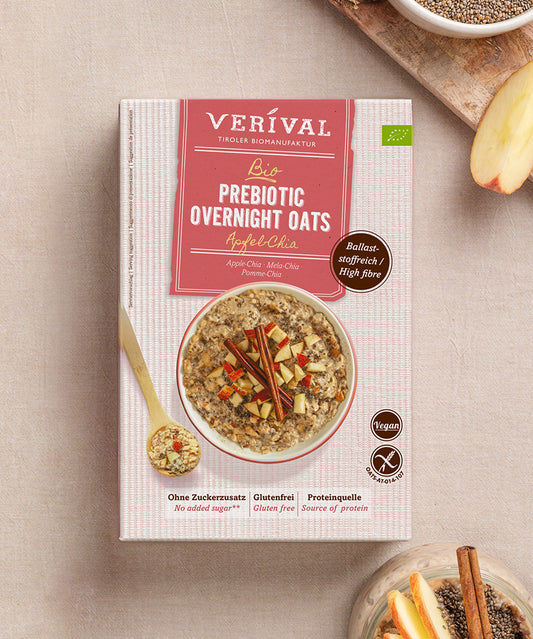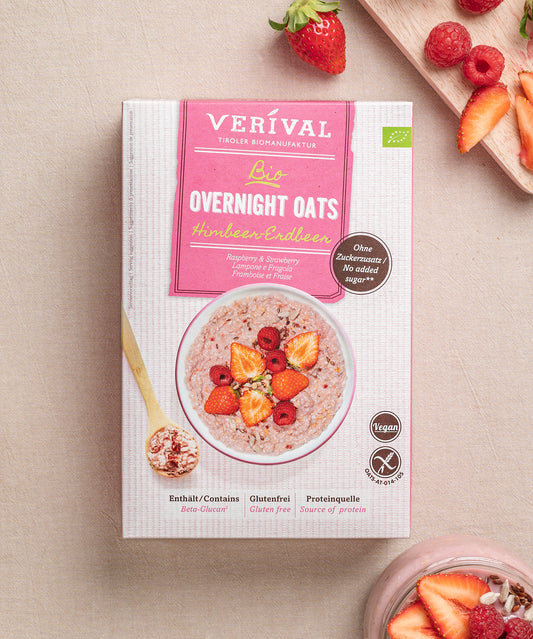Nutrients such as proteins, vitamin E or iron are essential for the body. But what happens if we do not consume enough of one of the numerous nutrients? And how do you recognise a nutrient deficiency in the first place? These are the questions we will address in this article.
Nutrient-rich porridges from Verival – discover them now
What nutrients are there?
Nutrients can be roughly divided into macro- and micronutrients. The macronutrients include the three energy suppliers fats, carbohydrates and proteins . The micronutrients, on the other hand, are divided into two further groups – vitamins and minerals.
While macronutrients are, roughly speaking, essential for the body as energy suppliers, micronutrients play a crucial role at the biochemical level and thus in the process of numerous metabolic processes in the body.
How to recognise a macro-nutrient deficiency
A deficiency of an energy supplier for the body is very unlikely in affluent societies such as Austria or Germany. In most cases, the problem in richer countries is increasingly that too much is consumed and thus problems arise from being overweight.
However, if a deficiency of macronutrients develops, this becomes very threatening for the body. Because every organism needs a certain amount of energy, and if it does not get enough, the body's functions can no longer be optimally maintained. However, the human body has a sophisticated system to counteract this and prevent a deficiency.
In a relaxed state, the body mostly uses fats, because the fat stores in the body and the energy content per gram of fat are very high. In situations in which the organism needs energy more quickly, the body switches from fat utilisation to carbohydrate burning, as these are broken down more quickly and thus represent more efficient sources of energy. Proteins, on the other hand, are only used as an energy source in exceptional cases, as they are only moderately suitable for this. Their primary function is to provide material for building body structures such as the musculature.
A deficiency of these nutrients is therefore not normally a danger, since the fat stores alone in a person of normal weight, with 80,000 to 100,000 kilocalories would be sufficient for the theoretical completion of around 30 marathons. However, we should be more concerned about a deficiency of micronutrients, as this can happen much more quickly.
How to recognise a micro-nutrient deficiency
Micronutrients, which can be categorised as vitamins or minerals, include a wide range of different nutrients with a wide range of different functions and tasks. It can therefore be quite difficult to keep track of them all and to ensure that your diet actually contains sufficient quantities of all the micronutrients you need.
Fortunately, your body has a well-organised and well-thought-out system for this too. Some of the micronutrients do not have to be consumed daily because your body can store them, thus providing a certain buffer. Other nutrients, such as water-soluble vitamins, cannot be stored. This makes a daily supply extremely important.
However, if you do not consume enough micronutrients over a period of time, your body will signal its emergency situation to you with the help of symptoms.
How to recognise a vitamin deficiency
Vitamins can be roughly divided into water-soluble and fat-soluble vitamins. While fat-soluble vitamins can be stored by your body, this does not apply to almost all water-soluble vitamins. Only vitamin B12 is an exception and can therefore be stored by the body, similar to fat-soluble vitamins. You can find out more about this unique vitamin here.
A vitamin deficiency can generally manifest itself in a variety of ways, depending on which vitamin is specifically affected. General symptoms of vitamin deficiency are as follows: fatigue, emotional instability, depressive moods, concentration problems and impaired short-term memory.
As you can see, these symptoms are very non-specific and could theoretically arise from a variety of causes. However, the symptoms only become a little more specific in the advanced stages of vitamin deficiency. Examples include a weak immune system and the associated increased susceptibility to infection (vitamins A, B6 and C), cramps (vitamin B6), visual disturbances and increased bleeding tendencies (vitamin K).
If you suspect a vitamin deficiency, you should definitely see an expert. Suitable contacts include general practitioners, nutritionists, dieticians or nutritional physicians.
Useful information about the vitamin B complex – this way
How to recognise a mineral deficiency
Minerals can be categorised as either bulk or trace elements and, like vitamins, are involved in a variety of important biochemical reactions in your body.
Trace elements, as the name suggests, are only found in small amounts in the body. They include iron, iodine, zinc and fluorine, among others. Bulk elements, on the other hand, are found in larger quantities in the human organism. The most important of these are calcium, potassium, sodium and magnesium.
As with vitamins, the initial deficiency symptoms are generally very unspecific and therefore difficult to recognise . The symptoms only become more specific when you take a closer look at certain minerals and the deficiency is more pronounced.
You can recognise a magnesium deficiency, for example, by muscle cramps. Constipation or diarrhoea, on the other hand, can indicate a potassium deficiency, since this bulk element has a strong influence on your digestion. Symptoms of a zinc deficiency, on the other hand, are expressed through a weakened immune system, and subsequently through an increased susceptibility to infection. You can recognise an iron deficiency by symptoms such as tiredness, headaches and shortness of breath.
Other symptoms include low blood pressure (sodium), brittle bones (calcium), tachycardia (electrolytes), and agitation and insomnia (magnesium).
Again, if you suspect a mineral deficiency, it is best to consult a suitable expert (nutritionist, dietician) and have a blood test to determine whether you have a nutrient deficiency and how you can best remedy it.
A quick tip: oats are an excellent source of minerals because they contain plenty of magnesium, copper, iron and zinc and are also a great source of healthy proteins, fats and carbohydrates.
How to successfully counteract a nutrient deficiency
To avoid a nutrient deficiency, you should eat a diet that is as balanced and varied as possible. While macronutrients are usually consumed in sufficient quantities, you should take special care to consume enough micronutrients.
The best thing to do is to follow these tips – make your meals as colourful as possible. This not only looks great, but also helps you to consume a variety of different vitamins and minerals. A breakfast with porridge as the base and a selection of fresh berries, for example, not only looks delicious, but also provides you with a variety of important nutrients.
The seasonal calendar for colourful fruit and vegetables – discover it now
Incidentally, the number of different foods you eat each week is another good guide. According to this, you should consume at least twenty different foods within a week to provide your body with the best possible supply of healthy vitamins and minerals. So, we hope you eat a colourful diet and enjoy your meal! 😉
























